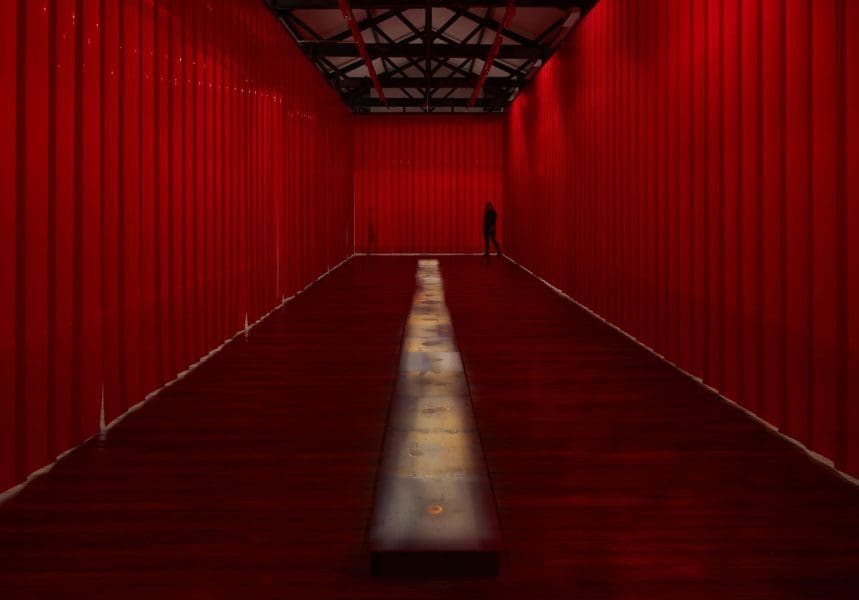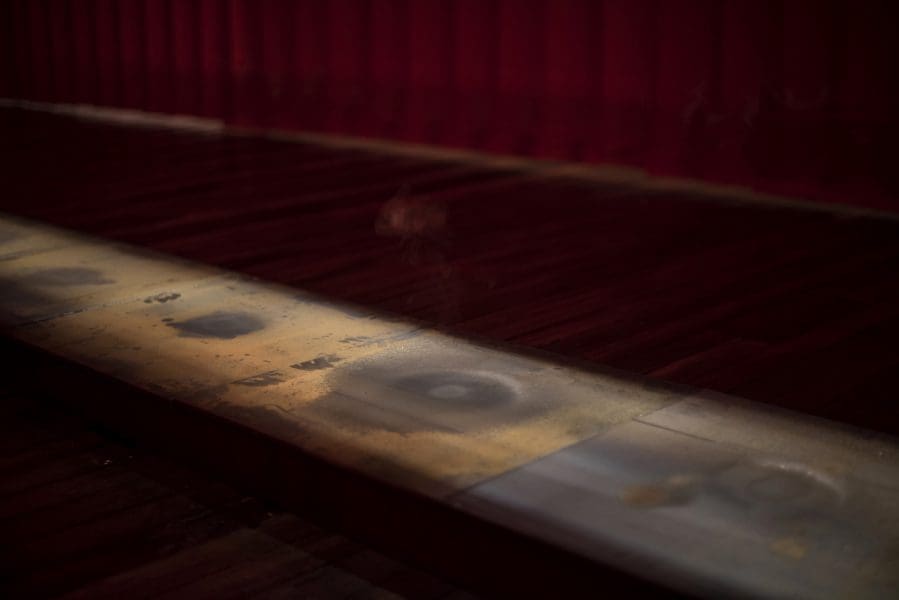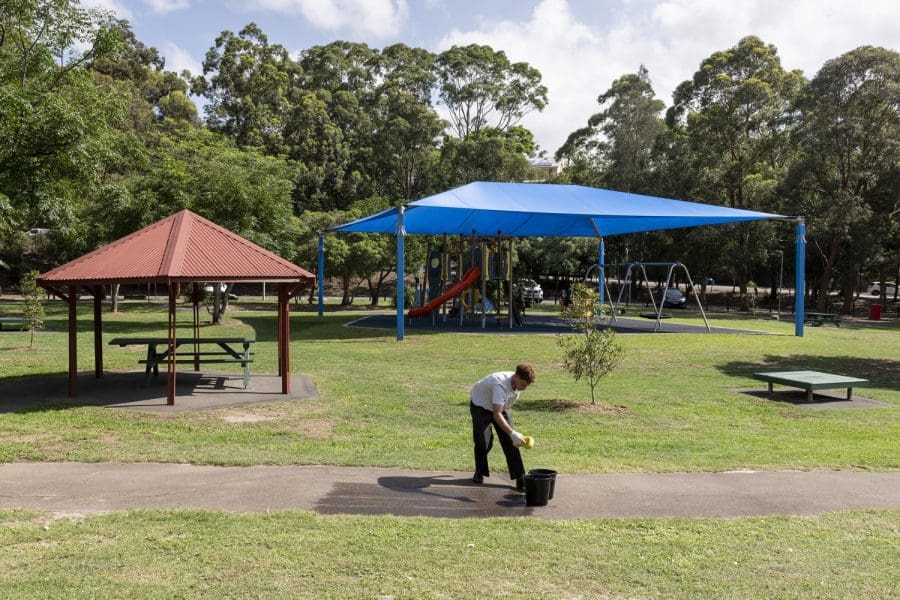
Piercing the veil
A new exhibition at Buxton Contemporary finds a rich complexity in the shadowy terrain between life and death.

Teresa Margolles, Approximation to the Scenes of the Facts, 2020, mixed-media installation. Installation view, 22nd Biennale of Sydney, National Art School, 2020. Courtesy the artist and Galerie Peter Kilchmann, Zurich. Photo: Zan Wimberley.

Teresa Margolles, Approximation to the Scenes of the Facts, 2020, mixed-media installation. Installation view, 22nd Biennale of Sydney, National Art School, 2020. Courtesy the artist and Galerie Peter Kilchmann, Zurich. Photo: Zan Wimberley.

Teresa Margolles, Approximation to the Scenes of the Facts, 2020, mixed-media installation. Installation view, 22nd Biennale of Sydney, National Art School, 2020. Courtesy the artist and Galerie Peter Kilchmann, Zurich. Photo: Peter Morgan.

Teresa Margolles, Approximation to the Scenes of the Facts, 2020, mixed-media installation. Installation view, 22nd Biennale of Sydney, National Art School, 2020. Courtesy the artist and Galerie Peter Kilchmann, Zurich. Photo: Zan Wimberley.

Volunteer washing a site near where a woman aged 32 was stabbed to death and dragged to the play area of the Buffalo creek reserve park. Police have not identified the killer. Photo: Teresa Margolles.
Please note, when this article was first published in March Teresa Margolles was featured at the NAS Gallery. Her installation was subsequently moved to Carriageworks where it will be on show from 7 August to 26 September.
“No soy un activista. Soy un artista,” explains Mexican artist Teresa Margolles. Even with my nearly non-existent Spanish I know what she is saying, before her sister Margarita translates for me. “I am not an activist. I am an artist.”
Sporting a black T-shirt, cargo pants, Doc Martin boots, long plaits and one of those military style hats made popular by Fidel Castro, Margolles looks like a revolutionary. Her gaze is determined. Never mind what she is wearing, she does not look like someone you should argue with. But I am not convinced.
Margolles is known for creating powerful, visceral installation and performance works – often literally infused with actual bodily fluids – that draw attention to violent crimes and the inequities the poor, the marginalised, and the dispossessed continue to suffer, even after death. Her most recent work, a massive sculptural installation made for the 2020 Biennale of Sydney, is dedicated to exposing entrenched societal misogyny and drawing attention to the untold women who are murdered every year in Mexico and around the world. Her work highlights the terrible repercussions of acts of lethal violence: how they reverberate through a family, a nation and a culture. If that isn’t activism I don’t know what is.
With a gesture indicating the long blood-red strips of thick vinyl that delineate the huge rectangular enclosure of her work, Approximation to the Scenes of the Facts, which fills the entire upper floor of the NAS Gallery, Margolles explains, “This is the mutilated body.” And not just any body. The murders Margolles is currently concerned with are femicides. This, she tells me, is the female body: exposed, penetrated, slashed into strips creating multiple wounds, multiple entry points. Knifing, she says, is statistically the murder method of choice for killing women in Australia.

Margolles is clearly not squeamish. In fact, she trained as a forensic technician, not as an alternative career, but as a way of extending her reach as an artist; a way of coming to terms with the persistent presence of death in life. For a time the artist actually worked in a morgue. “The morgue of any country in the world is like a social thermometer,” she says. “The way people die in a city reflects the city.”
For this new work, developed specifically for the Biennale after arriving in Sydney, Margolles identified 20 women murdered in and around the city in the last two and a half years. She then visited the sites of these femicides, and with the help of art student volunteers, methodically washed an area near where each woman died. She describes this performative act as symbolic, a way of “lifting memory.” Inside the red vinyl enclosure, each of the 20 dead women is represented by a heated square plate of steel. Water saved from washing each site drips slowly and steadily onto these plates only to evaporate instantly with an audible hiss, a poignant sound that Margolles calls “the sigh of loss.”
In this way the work subtlety, yet dramatically, emphasises the ephemeral nature of all life; its swift fragility. But, although fleeting, each droplet leaves a visible stain on the dark steel. “Every murder leaves a mark,” Margolles says. “Even after months, years, the first drop – the moment when the family is told– it will always be there.”
The work Margolles has made in Sydney draws attention to 20 recent femicides committed here, not a number to be proud of. But the situation is much worse in her home country, Margolles says. “Always, I am thinking of Mexico,” where, she tells me, 300 women were murdered in just one month. “Every murder destroys a family,’ she explains. “It then goes on to the community, the country.”
Femicide in Mexico made headlines on International Women’s day this year when thousands of women went on strike and marched in protest. The Guardian reported that more than 10 women are murdered every day in Mexico. “They do it because they can,” Margolles says. “Because they can get away with it.” Femicide has been on the rise in Mexico since 2006, according to the artist, and the bulk of these murders are unsolved. They are the result, she says, not of drug deals gone wrong, or gang violence, but of deep seated misogyny. “Women are seen as disposable. Little girls are growing up understanding that they are disposable. Mothers are screaming.”
You can’t hear the screams of these women in Margolles’s Approximation to the Scenes of the Facts installation, but it does elicit a corporeal reaction to their suffering. Her work engages multiple senses: sight, sound, and even smell thanks to the outgassing of the thick vinyl and the ferric tang of water on hot steel. “I research loss and pain so people can understand it,” Margolles says. “My intention is to be a filter so audiences can feel the pain.”
Margolles insists that she isn’t an activist. “I am an artist and I use all the limitations of an artist,” she says. Born in 1963, she points out that “I am part of a generation that hasn’t changed the world.” She fixes me with her steely gaze and it is clear that nevertheless she will not stop trying.
Teresa Margolles
22nd Biennale of Sydney: Nirin
Carriageworks
7 August – 26 September